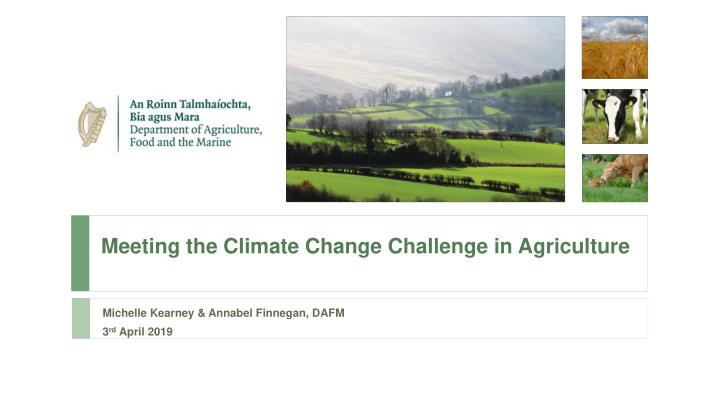



Meeting the Climate Change Challenge in Agriculture Michelle Kearney & Annabel Finnegan, DAFM 3 rd April 2019
The Climate Change Challenge GHG Targets Renewable Energy Energy Efficiency GHG Emissions Targets Targets > 30% of GHG 20% emissions 20% Energy Efficiency emissions from reduction by 2020; 16% of energy by 2020 Agriculture demand from 30% by 2030 renewable by 2020 32.5% Energy Efficiency EU agricultural Both GHG and by 2030 emissions are approx. 32% EU target by 2030 ammonia emissions 10% projected to increase by 2030
Sustainability is key An Roinn Talmhaíochta , Bia agus Mara │ Department of Agriculture, Food and the Marine
Current CAP & the Reform of CAP Current CAP CAP POST 2020 Pillar I – Simplifying and modernising the policy Direct payments to farmers on an annual basis More targeted, result and performance based support Pillar II – Fairer distribution of direct payments Enhancing environmental and climate ambition Infrastructure, Environment and Development Support 40% of CAP’s budget is expected to contribute to climate action An Roinn Talmhaíochta , Bia agus Mara │ Department of Agriculture, Food and the Marine
Climate Friendly Farming GLAS BDGP RDP 2014-2020 TAMS (CAP Pillar II payments) Nitrates Knowledge Transfer Programmes European Innovation Partnerships
Role of Agriculture in Energy Production and Energy Use
Energy & Agriculture Energy MACC Energy On-Farm Efficiency Energy On-Farm Generation Supplier of Bioenergy Feedstock's Sustainable Energy Agriculture Sector
Forestry > 300,000 ha planted since 1990 and € 2.5 billion of state investment to date Contributes € 2.3 billion to GDP, 12,000 employed Irish Round harvest was approximately 3.54 million cubic metres in 2017 Nearly 4 million cubic metres of roundwood harvested each year. This will more than double to 8 million cubic metres by 2035 Irish forests have sequestered about 3.8 million tonnes of CO 2 per year from the atmosphere (2007-2016) Demand for forest products is expected to increase by 20% by 2030 across Europe An Roinn Talmhaíochta , Bia agus Mara │ Department of Agriculture, Food and the Marine
Forestry: Challenges & New Incentives Afforestation Low afforestation rates: ~ 4,000 ha in 2018 Forest Roads Small plantations, average private grant aided 8.8 ha Woodland Improvement Road construction in private estate Neighbourwood Knowledge transfer groups Bioeconomy and biomass supply shortfall Forest Certification Potential wood fibre available in RoI for energy, wood based panels and other uses to increase from ~1.9 million m 3 in 2018 Management Plans to ~ 4.2 million m 3 in 2035 An Roinn Talmhaíochta , Bia agus Mara │ Department of Agriculture, Food and the Marine
Energy Efficiency & Renewable Energy Supports LED Targeted Agriculture Modernisation Scheme Lighting Energy Efficiency Measures Heat Energy Transfer Efficiency Units Upgrades Renewable Energy T echnology Supports Biomass Solar PV Boilers Horticulture Programmes Producer Organisation Scheme Commercial Horticulture Scheme
Energy Efficiency & Renewable Energy Supports EIP Projects Small Biogas Demonstration Programme T otal investment Biorefinery Glas Project of € 3 million Irish Biochar Cooperative Society Animal-By Product Regulations T o encourage alternative safe domestic disposal outlets including the safe use of ABP as a feed stock in biogas plants Environmentally friendly, sustainable process 10 biogas plants under DAFM regulation operation with 2 additional plants shortly
Energy in Horticulture
Producer Organisation (PO) Scheme Producers getting together: Concentration of supply : larger supply base Greater bargaining power Operation Programme: Covers planning of production, quality, marketing, R&D, crisis prevention management and environmental actions Eligible for 50% support Progress is monitored against pre-set targets and performance indicators Energy in Horticulture
Environmental actions At least 2 environmental actions or 10% of the programme expenditure National Environmental Framework • Climate change • Nature and Biodiversity • Natural resource and waste Energy in Horticulture
Climate Change Must achieve at least 15% energy use reduction Reducing emissions by replacing burner /boiler Reducing Energy requirement by insulation or installation of combined heat and power (CHP) Using Renewable energy such as biomass burner/boiler, Solar Panels, PV panels, wind turbines, geothermal systems, LED, Pumps and fans with variable speed drives. Energy in Horticulture
Nature & Biodiversity Use of natural pest control agent Use of inherent disease resistance Use of physical weed control Targeted application of pesticides Organic production Energy in Horticulture
Natural Resources & Waste Re-use of organic waste production. Capture and re-use of water in growing systems Capture and treatment of rain water from rooftops Energy in Horticulture
Grant aid scheme for commercial Horticulture Competitive scheme € 6 M budget 2019 40% grant aid rate Objectives of the scheme • Promote diversification • Improve quality • Improve work conditions • Facilitate environmental friendly practices Energy in Horticulture
Grant aid scheme for commercial Horticulture Thermal Screen/insulation More efficient Boiler/burner LED Re-usable nets and fleece Capture, storage and use of rain water Precision Agriculture Energy in Horticulture
Meeting our Climate Change Targets Need to establish a base line Survey on energy use Put in place targets Energy in Horticulture
Recommend
More recommend